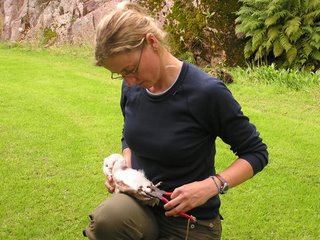I find the last few days of August to be wistful, even melancholy. With many summer migrant birds already flown south, grasslands brazen brown, rowan and brambles laden with berries, and the days perceptibly shorter, evidence of approaching cooler times is unescapable.
My last weekend of August commenced with a bird-ringing session in the garden of birdy/ballet/soccer friend Pam near Huntingdon (Thursday 24 August). A catch of 21 birds included a pleasing variety of species including green and gold-finches, robin and wren. Then navigation of the infamous M25 London Orbital saw me to the cottage of son Alun and partner Trudy in the village of
Hambledon, Hampshire (the cradle of cricket), in good time for a fish and chip supper.
Friday dawned warm and sunny and with Alun and Trudy both at work I explored the nature reserves of
Farlington Marsh and
Titchfield Haven where large numbers of migrant birds (including waders such Grey Plover, Black-tailed Godwit, Whimbrel and Green Sandpiper, as well as Wheatears and Whinchats) were feeding up before their dash to sub-Saharan climes. The evening passed with an excellent meal at the local Vine pub, followed by a nightcap of a dram of whisky at home on the patio.

A Black-headed Gull with the eponymous 'black' head of the breeding season now reduced to a mere smudge behind the eye - the tell-tale sign that summer is almost over
The climax of the weekend occured on Saturday, at the Hambledon village Horticultural Show. This was of local interest because Alun had entered a bottle of elderberry wine in the competition and he and Trudy competed in the photography competition. An anxious couple of hours passed while the judging took place in the marquee followed by delight as Alun's wine was declared the winner in its class and the photographs won second and third prizes.
 Alun proudly displays his championship elderberry wine
Alun proudly displays his championship elderberry wine Even I had success, in winning a coconut in the coconut shy when my throw went straight and true. The collective success was celebrated with tea and cakes in the village hall. Dinner was cottage pie on the patio, washed down of course with championship red wine!
Afternoon tea in the village hall
Sunday was also warm and sunny, and called for an 8.5 mile walk from Titchfield to Bursledon, following the course of the Solent Way and the Meon Valley Strawberry Trail. Passing through a variety of habitats, a group of over 25 Little Egrets and other waterbirds was remarkable. The river taxi accross the River Hamble from Warsash to Hamble Village earned us an ice cream to give sustainence for the last leg of the walk to the Jolly Sailor pub at Bursledon where pints were enjoyed on the floating poontoon over the Hamble.
On Bank Holiday Monday we set off for a 6.5 mile walk into the South Downs where fine views out over the Solent to the Isle of Wight were had. The wildlife highlights of the walk were close views of a couple of Clouded Yellow butterflies, scarce migrants at this time if year. Also a close encounter with a hare before it hared off accross the field.
 Clouded Yellow, an uncommon summer migrant to Britain
Clouded Yellow, an uncommon summer migrant to Britain A hare caught napping!
A hare caught napping!The final event of the weekend on Tuesday evening was a barbecue at sister Jill's house in Cheshire in a clear but cool and breezy evening where jumpers were called for. As the Plough, Pleiades, Cassiopeia and Perseus emerged from the deepening twilight, a toast was drunk to "The Last of the Summer Wine".
 Last of the Summer Wine
Last of the Summer WineFarewell to summer. Hail Autumn! Welcome Orion!
I shall catch up with spring in Australia next month!
 Barn Owl (Photo linked to RSPB)
Barn Owl (Photo linked to RSPB) World Owl Trust Conser- vation Officer Sue rings a Barn Owl chick.
World Owl Trust Conser- vation Officer Sue rings a Barn Owl chick.











